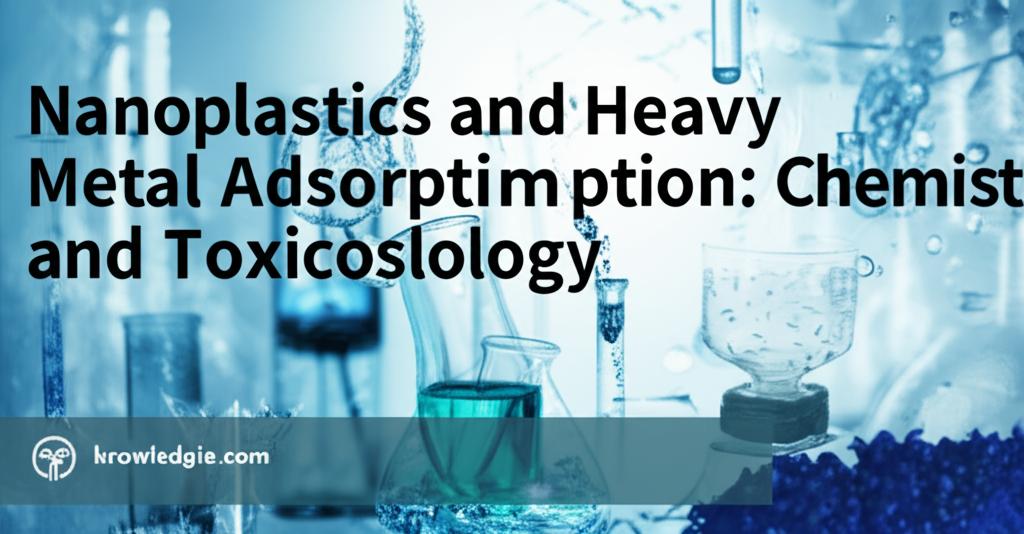Nanoplastics, plastic particles ranging from 1 to 1000 nanometers, are an increasing environmental concern due to their widespread presence and potential to adsorb and transport heavy metals. This interaction has significant implications for environmental chemistry and toxicology.
Adsorption Mechanisms and Influencing Factors:The adsorption of heavy metals onto nanoplastics is a complex process governed by several mechanisms, primarily electrostatic interactions, van der Waals forces, and π–π interactions. The surface properties of nanoplastics play a crucial role. For instance, many nanoplastics have a pH point of zero charge (pHpzc) around 3, meaning they carry a negative charge in natural aquatic environments, facilitating the adsorption of positively charged metal ions.
Several factors influence the adsorption capacity of nanoplastics for heavy metals:
- Nanoplastic Properties:
Type of Polymer: Different polymers like polyethylene (PE), polystyrene (PS), polypropylene (PP), and polyvinyl chloride (PVC) exhibit varying adsorption capacities due to differences in polarity, crystallinity, and surface functional groups. For example, PVC and PS often show higher adsorption capacities than PE.
Particle Size: Smaller nanoplastics generally have a larger specific surface area, leading to increased adsorption of heavy metals.
Surface Characteristics: Real-world nanoplastics, often with irregular shapes and rough edges, tend to have higher surface areas and thus greater adsorption capacities compared to lab-manufactured spherical nanoplastics.
Aging/Weathering: Environmental weathering processes, such as UV irradiation, can alter the surface of nanoplastics, increasing their specific surface area and the number of oxygen-containing functional groups (like aldehydes, ketones, and carboxylic acids). This typically enhances their adsorption capacity for heavy metals.
- Environmental Conditions:
pH: The pH of the surrounding water significantly affects the surface charge of nanoplastics and the speciation of heavy metals, thereby influencing adsorption.
Temperature: Temperature can affect adsorption rates and equilibrium.
Ionic Strength: The presence of other ions in the water can compete with heavy metals for adsorption sites, potentially reducing adsorption.
Contact Time: The duration of contact between nanoplastics and heavy metals influences the extent of adsorption.
Biofilm Formation (Plastisphere): Microorganisms readily colonize nanoplastics, forming biofilms. These biofilms can alter the physical and chemical properties of the nanoplastics, often increasing the abundance of functional groups like carboxyl and ketone groups, which can enhance heavy metal adsorption. The maturity of the biofilm can also play a role.
- Heavy Metal Properties: The type and concentration of heavy metal ions also determine the extent of adsorption. Some metals, like lead, have shown rapid and high adsorption rates onto certain nanoplastics.
The adsorption process can be described by various kinetic models (e.g., pseudo-first-order, pseudo-second-order) and isotherm models (e.g., Langmuir, Freundlich). These models help to understand the rate of adsorption and the equilibrium relationship between the concentration of heavy metals in the solution and the amount adsorbed on the nanoplastics. Generally, adsorption is a multi-stage process involving physical and chemical interactions.
Toxicological Implications:The adsorption of heavy metals by nanoplastics is a significant concern for environmental and human health for several reasons:
- Vector Effect: Nanoplastics can act as carriers, transporting adsorbed heavy metals through aquatic and terrestrial ecosystems and potentially into the food chain.
- Increased Bioavailability and Toxicity: The association of heavy metals with nanoplastics can alter their bioavailability and toxicity to organisms. Some studies suggest that this combination can lead to synergistic toxic effects, meaning the combined toxicity is greater than the sum of their individual effects.
- Cellular Uptake and Internalization: Nanoplastics, especially those smaller than 20 µm, can potentially pass through cell membranes. If these nanoplastics carry heavy metals, they can deliver these toxic substances directly into cells.
- Impacts on Organisms: Exposure to nanoplastics and adsorbed heavy metals has been linked to various adverse effects in organisms, including:
Aquatic Organisms: Reduced growth, oxidative stress, neurotoxicity, behavioral changes (e.g., altered swimming patterns in fish), reproductive issues, and gut microbiota imbalance.
* Plants: Reduced growth, lower photosynthetic pigment content, and oxidative stress. However, in some cases, nanoplastics might adsorb pollutants, leading to an antagonistic effect where the toxicity of the mixture is reduced.
- Human Health Concerns: Ingestion or inhalation of nanoplastics laden with heavy metals is a potential route of human exposure. Heavy metals are known to cause various health problems, including increased cancer risk, neurological damage, and developmental delays. While the exact human exposure dose from nanoplastic pollution is still being determined, the potential for these tiny particles to carry toxic metals is a growing area of research.
Despite increasing research, several challenges and knowledge gaps remain:
- Real-World Complexity: Most studies are conducted under controlled laboratory conditions. The behavior and interactions of nanoplastics and heavy metals in complex natural environments (considering factors like diverse particle types, weathering states, and presence of other pollutants) need further investigation.
- Environmentally Realistic Concentrations: More research is needed on the ecological and toxic effects of nanoplastics and adsorbed heavy metals at concentrations actually found in the environment.
- Long-Term Effects: The long-term consequences of exposure to these combined pollutants are not yet fully understood.
- Detection and Quantification: Detecting and quantifying nanoplastics and their adsorbed heavy metals in environmental samples remains challenging, though advancements are being made with techniques like laser-induced breakdown spectroscopy (LIBS), Fourier-transform infrared (FTIR) spectroscopy, Raman spectroscopy, and AI-assisted holographic microscopy.
- Mitigation Strategies: Developing effective and scalable strategies to remove nanoplastics and their associated contaminants from the environment is crucial. Current research explores methods like adsorption, membrane filtration, photocatalysis, and electrochemical methods.
The interaction between nanoplastics and heavy metals represents a significant and emerging environmental challenge. Nanoplastics readily adsorb heavy metals, influenced by a variety of particle and environmental factors. This adsorption can alter the transport, bioavailability, and toxicity of heavy metals, posing risks to ecosystems and potentially human health. Continued research is essential to fully understand these complex interactions, assess the true scale of the risks, and develop effective mitigation and remediation strategies.

